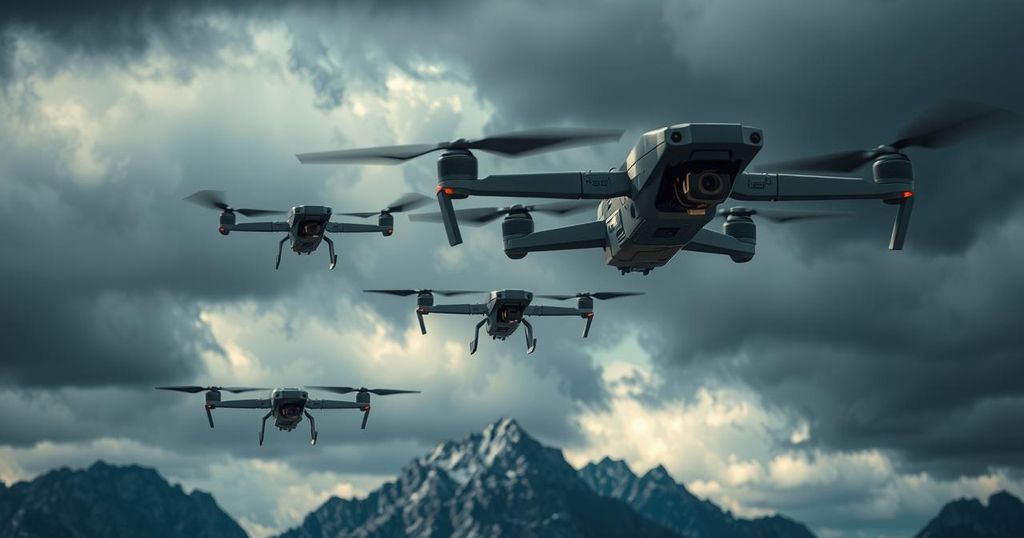Ukraine’s Drone Strikes on Russia Intensify Challenges for Peace Talks

Ukraine conducted a major drone attack on Russian airfields just before peace talks in Istanbul, which resulted in an agreement on casualties but no progress towards a ceasefire. The attacks raise concerns for Russia, especially if nuclear facilities were targeted. Both sides remain at an impasse over negotiation terms, with Russia unwilling to concede territory and Ukraine insisting on a ceasefire before talks can resume.
In a dramatic turn, Ukraine launched a significant drone attack on Russian airfields just a day prior to the scheduled peace talks between the two nations in Istanbul, marking the largest drone offensive against Russian assets to date. The negotiations were cut short after merely an hour, yielding an agreement solely on the exchange of thousands of casualties, but failing to produce any meaningful dialogue on a ceasefire or the cessation of hostilities. This follows an earlier round of negotiations in May that also concluded without consensus.
The drone strikes were noteworthy not only for their scale but also due to their locations, which included airfields deep in Siberia. This raises concerns for Russia, especially if any of the attacked sites house nuclear facilities or strategic bombers. Reports suggest that the potential targeting of nuclear-related facilities could provoke a serious response from Moscow, particularly as such assets have, until now, been avoided in military strikes. The fear is that this could indicate a shift in Ukraine’s strategy or possible Western involvement, which Russia is likely to investigate thoroughly.
Historically, Ukraine has not sought to target Russian nuclear capabilities because of the substantial repercussions that would follow, especially amid fears of NATO involvement. The drone strikes have exposed vulnerabilities within Russian defense in a way that may not have been expected. Earlier, Ukrainian drones had targeted Moscow during the Victory Day celebrations, but this new assault stretches the battle into the heart of Russian territory.
Another point that stands out is the method of warfare. The Ukrainians used trucks to launch drones over vast distances, allowing strikes deep within Siberia. This method might indicate growing operational sophistication or new logistics capabilities on the part of Ukraine. However, Russian leadership is likely to be more concerned about the implications of such attacks than the physical damage inflicted.
On the political front, while there may be military concerns for Russia, President Vladimir Putin’s regime appears to maintain strong domestic support, which could mitigate potential backlash against the drone strikes. Nonetheless, the lack of progress in peace negotiations remains a critical issue as both Ukraine and Russia grapple with fundamental disagreements.
Ukraine insists on a ceasefire lasting at least a month before any negotiations can proceed, a stance that has garnered some backing from Western allies, save for the U.S. Conversely, Russia expresses willingness to discuss a ceasefire if accompanied by a clear pathway toward resolution, asserting that any negotiation should address critical issues such as Ukraine’s neutrality and the welfare of Russian-speaking citizens in Ukraine.
In light of ongoing discussions, both nations appear entrenched in their positions. Russia has been steadily advancing on the ground while Ukraine tries to retain its territory and resources. An implicit fear for Russia is that granting a month-long ceasefire would allow Ukraine the opportunity to regroup, which they are reluctant to permit.
The negotiation process still feels quite nascent, primarily involving mid-level officials without the authority to finalize any agreements. Delegations from both sides are under significant pressure, particularly from the United States, to come to a resolution . The Russians are led by Vladimir Medinsky, a former Culture Minister, while the Ukrainian delegation is headed by Defence Minister Rustem Umerov. They aim to outline a framework that can eventually be put forth for decision-making by the leaders, Putin and Zelenskyy.
In summary, Ukraine’s recent drone strikes on Russian airfields just before upcoming peace talks have raised numerous questions about the future of these negotiations. While both sides agreed on the exchange of casualties, deeper issues remain unresolved, including fundamental disagreements over ceasefire terms and political demands. Russia’s investigation into the implications of these strikes, especially concerning their nuclear facilities, highlights the tension between military strategy and political realities. The situation remains fluid as the two nations wrestle with the complex dynamics of war and diplomacy in the hopes of finding an eventual resolution.
Original Source: indianexpress.com








